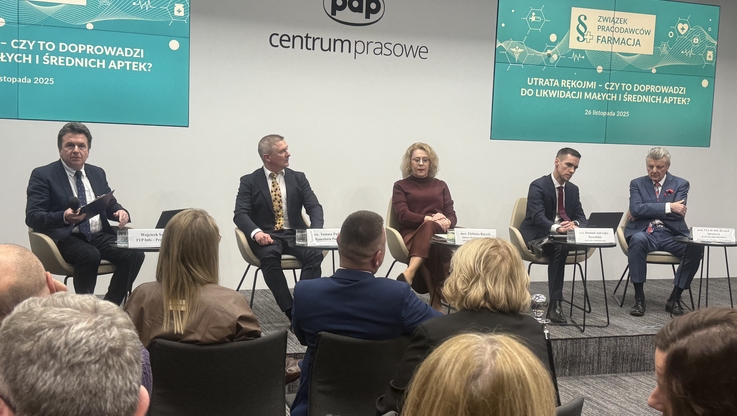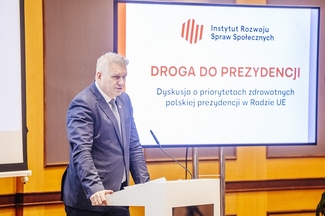Pobierz materiał i Publikuj za darmo
Experts from the ESPON research programme indicate a number of initiatives undertaken by the European Commission and individual regions of the continent that could help in the future digital transformation of the healthcare system in Europe.
As the ESPON report suggests, one of the pillars of the EU is the freedom of movement of people, allowing them to visit or live in any country of the Community and benefit from healthcare there. However, the selection of an appropriate method of treatment, both of minor ailments and infectious diseases (such as COVID-19) or chronic conditions (e.g. cancer), requires the maximum amount of information on the patient's medical history. Unfortunately, as ESPON experts remind us, the prompt and secure transfer of such data between the healthcare systems of individual Community countries is still an objective to be achieved.
The digitisation of medical care is obviously progressing, but still predominantly carried out on a domestic scale. Also in Poland, we commonly use the EMR (Electronic Medical Record) solution, i.e. a digital version of traditional medical records created within a hospital or clinic.
Meanwhile, most EU member states use an EHR (Electronic Health Record), which is an electronic record containing all patient data that can be freely exchanged between healthcare providers. However, the European Commission alerts that both systems often generate data transfer problems within a single country, not to mention international flows. Furthermore, several of the solutions adopted are not fully compliant with the Regulation of the European Parliament and of the Council of the EU on the protection of individuals with regard to the processing of personal data. This leads to a lack of technical interoperability between documentation systems, as well as problems on issues such as patient identification, health professional authentication, and language semantics or data privacy.
The response to this challenge is the digital cross-border electronic health service (eHDSI), which is the infrastructure that will ensure continuity of care for EU citizens when they travel to another Community country. It will enable Member States to exchange medical data in a secure, efficient and interoperable way. These are two tools: the e-prescription (which enables medicines to be purchased anywhere in the Union) and the patient file (which contains information on important aspects of health, such as allergies, current medication, illnesses and surgical operations).
Alongside the seven Member States where these services are currently being implemented, 18 other countries, including Poland, have committed to developing similar solutions that will link their national eHealth systems to the EU’s common information technology infrastructure. Initially planned to continue until 2022, the pan-European implementation has been postponed until 2025 due to the COVID-19 pandemic. In some Member States, the use of e-prescriptions and patient records has been common practice for many years - but in others, pilot projects have only recently started.
Digital technologies such as artificial intelligence, 5G, the Internet of Things or robotics provide new opportunities to transform the way we receive and deliver health and care services. According to the authors of the ESPON report, in order to boost this digital innovation, in the first place regional ecosystems need to be created, bringing together traditional healthcare providers, the public sector, the pharmaceutical industry, companies and research institutes.
An example of such cooperation in the area of digitisation of healthcare services is OuluHealth, a Finnish ecosystem aiming to implement health innovations and boost health-tech business. It actively develops partnerships with researchers, business networks and regional, national and international research institutes. In cooperation with other ecosystems from Scandinavia, it is involved in improving the quality of care for the elderly, etc. Similar initiatives supporting the development of modern medical solutions are in place in Belgium, Italy and Spain.
Healthcare providers are also natural candidates for joint procurement of digital innovations. This implies an increasing cooperation between institutions from different EU countries in the area of public procurement.
Public procurement of innovation (PPI) targets challenges that can be met with new solutions close to commercialisation or already commercialised in small quantities. Pre-commercial procurement (PCP), on the other hand, is preferred when there are no solutions close to market and when new R&D activities are needed.
ESPON recalls that so far the EU has supported a total of 13 PCP projects, 3 PPI projects and 5 combined PCP and PPI projects on digital health with EUR 61.1 million (total investment of EUR 82.7 million), benefiting more than 200 procurers across the Union. Approximately 38% of the procurers were public authorities (excluding research organisations and higher education institutions), 18% were university hospitals and 16% were for-profit organisations. The most active procurers under PCP and PPI were organisations located in regions with a strong innovation performance – Belgium, Denmark, Finland and Sweden.
Source: PAP MediaRoom
Pobierz materiał i Publikuj za darmo
bezpośredni link do materiału
| Data publikacji | 30.07.2021, 12:00 |
| Źródło informacji | PAP MediaRoom |
| Zastrzeżenie | Za materiał opublikowany w serwisie PAP MediaRoom odpowiedzialność ponosi – z zastrzeżeniem postanowień art. 42 ust. 2 ustawy prawo prasowe – jego nadawca, wskazany każdorazowo jako „źródło informacji”. Informacje podpisane źródłem „PAP MediaRoom” są opracowywane przez dziennikarzy PAP we współpracy z firmami lub instytucjami – w ramach umów na obsługę medialną. Wszystkie materiały opublikowane w serwisie PAP MediaRoom mogą być bezpłatnie wykorzystywane przez media. |







